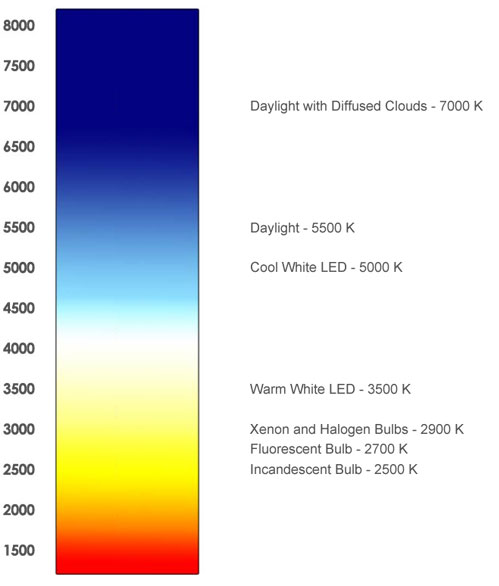Amperage
The strength of an electrical current.
Beam
The angle at which a light travels from a light source.
Class II
Class II drivers/transformers have a maximum VA (Volt-Ampere) rating of less than 100 and a maximum secondary output of 30 VAC. The maximum VA generally offered is 75 and the most common secondary voltage is 24 VAC. Class II drivers/transformers are either inherently or non-inherently limited. This means that the maximum output current of the driver/transformer is limited, either by the intrinsic coil impedance or by a fuse or circuit breaker.
CRI
Color Rendering Index is a quantitative measure of the ability of a light source to reproduce the colors of various objects faithfully in comparison with an ideal or natural light source. Higher CRI numbers are important in installations where true color is important such as clothing or art displays.
Color Temperature
This is a measurement in Kelvin of the color of light a source produces. Higher color temperatures (5,000 K or more) are cool (blueish white) colors; lower color temperatures (2,700–3,500 K) are warm (yellowish white through red) colors.

Current
The amount of electricity that flows through a conductive surface measured in unit Amp.
Driver
A device that transforms incoming household AC (alternating) current to low voltage DC (direct) current. The driver also maintains constant current without fluctuations which is necessary for correct LED operation and life.
LED
An electronic semiconductor device that emits light when an electric current passes through it.
Rated Lumens
A measurement of the power of light emitted from a source. The difference between LED lumen versus lumens from an incandescent or fluorescent source is that all of the lumen output is directed forward as opposed to a bulb where lumens come off the source in all directions. Lumens are lost on the back side of a bulb. In most cases, lumen ouptut indicated on the Maxim Lighting Web site is for the combination of bulbs/LEDs, not the actual fixture itself. Lumen output can be reduced up to 30% when bulb/LED is placed behind glass enclosure or other type of shade.
Lumens per Watt
A measurement of the efficiency of the light. The higher the lumens generated by each watt the greater the overall efficiency of the light. For LEDs, the higher efficiency LED are generally more expensive.
Milliampere (mA)
A unit of current equal to one thousandth of an ampere.
Rated Life Hours
An average rating, in hours, indicating when 50% of a large group of lamps have failed, when operated at nominal lamp voltage and current; manufacturers use 3 hours per start for fluorescent lamps and 10 hours per start for HID lamps when performing lamp life testing procedures; every lamp type has a unique mortality curve that depicts its average rated life. For Photo-Optic specialty lamps, average rated life refers to the operating period after which on statistical average, 50% of the lamps will perform within their specified values.
Voltage
A measurement of the energy contained within an electric field, or an electric circuit, at a given point. The greater the voltage, the greater the flow of current through a conductive medium. Voltage can be direct or alternating. A direct voltage maintains the same polarity at all times. In an alternating voltage, the polarity reverses direction periodically.
Voltage Drop
A decrease in voltage along a conductor through which current is flowing. The decrease is caused by the resistance of the conductor.
UPS Oversize
Any box shipped via UPS that that is larger than 3 cubic feet in size will be charged shipping costs based on its dimensional weight rather than the actual weight of the package.
Wattage
A measurement of electrical power required by an appliance or device.
Wattage Comparison
Wattage comparison between LED, Incandescent and Fluorescent




